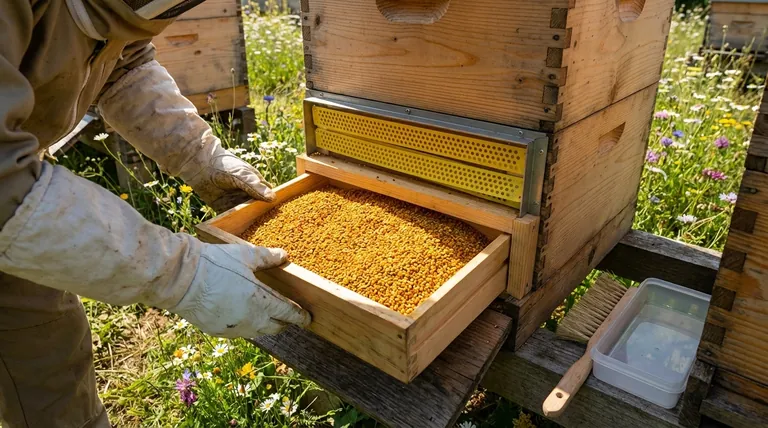For optimal pollen quality and hive health, you must harvest pollen from your traps frequently. The standard best practice is to collect it daily or, at the very latest, every other day. This schedule is critical for preventing spoilage and ensuring the pollen remains a valuable nutritional resource.
Successful pollen harvesting is a race against moisture and contamination. Frequent collection is not merely a suggestion; it is the most critical factor in preserving the pollen's nutritional value and preventing the trap itself from becoming a liability to the hive.

The Rationale Behind Frequent Collection
Understanding why daily collection is recommended allows you to make better management decisions, especially when conditions are not ideal. The core reasons revolve around preservation and preventing negative consequences for the colony.
Preventing Mold and Spoilage
Freshly collected pollen has a high moisture content, making it an ideal breeding ground for mold and mildew. If left in the collection drawer for more than a couple of days, especially in humid weather, it will quickly begin to spoil and become unusable.
Maintaining Nutritional Value
Pollen is harvested for its high protein content, which is essential for bee development. The nutritional integrity of this protein degrades over time. Frequent harvesting ensures you are preserving the freshest, most nutritious pollen possible.
Avoiding Trap Overload and Pests
A neglected pollen trap can quickly overfill. This not only stops the collection process but can also impede bees' access to the hive. Furthermore, a buildup of old, damp pollen can attract pests like wax moths and small hive beetles, creating a new problem you must manage.
Understanding the Trade-offs of Infrequent Collection
While daily collection is ideal, it's important to understand the specific risks you run by extending the time between harvests. The consequences go beyond simply lower-quality pollen.
The Risk of Total Loss
Delaying collection by even a few days can lead to complete spoilage. Moldy pollen is not just less nutritious; it is a total loss and must be discarded. It cannot be fed back to the bees.
Increased Pest Pressure
Pests are drawn to the scent of fermentation and decay. Leaving pollen in the trap for extended periods is an open invitation. This can lead to an infestation that starts in the trap but can potentially spread to the hive itself.
Unnecessary Stress on the Colony
A full or clogged pollen trap can create a "traffic jam" at the hive entrance. This slows down foraging operations and places unnecessary stress on the colony as they struggle to get in and out. This can impact the hive's ability to collect nectar and water.
The Purpose of Harvested Pollen
Harvesting pollen is not just about collecting a surplus; it's a strategic management tool for strengthening your colonies when natural resources are scarce.
Creating a Protein Reserve
Beekeepers collect pollen to create a reserve of high-quality protein. This is invaluable for early spring brood rearing, allowing the colony to build up its population before natural pollen sources become abundant.
Supplementing a Colony's Diet
This stored pollen is often mixed with other ingredients like soybean flour or brewer's yeast to create pollen patties. These patties are placed inside the hive, providing a direct and accessible protein source to fuel the rearing of new bees and support a healthy queen.
Making the Right Choice for Your Goal
Your harvesting schedule should align with your specific goals and environmental conditions.
- If your primary focus is maximizing pollen quality: Harvest daily, especially during humid weather, to capture the pollen in its freshest state.
- If your primary focus is a balance of effort and results: Harvesting every other day is a reliable standard that prevents most common issues like mold and pests.
- If you are experiencing a rainy period: Check and empty your traps immediately after the rain subsides, as the spike in humidity dramatically accelerates the risk of spoilage.
Consistent harvesting is the key to turning your bees' hard work into a valuable resource for your apiary.
Summary Table:
| Harvesting Frequency | Key Benefit | Key Risk of Delay |
|---|---|---|
| Daily | Prevents mold, preserves maximum nutritional value | N/A (Ideal Practice) |
| Every Other Day | Good balance of quality and effort | Slight risk of spoilage in humid conditions |
| Less Frequently | Not Recommended | High risk of total spoilage, pest attraction, and colony stress |
Ensure your pollen harvesting is a success with reliable equipment from HONESTBEE.
As a leading wholesale supplier to commercial apiaries and distributors, we provide the durable, high-performance pollen traps and beekeeping supplies you need to operate efficiently at scale. Proper harvesting is only possible with dependable tools.
Let HONESTBEE support your operation's growth and productivity. Contact our team today to discuss your wholesale needs and discover how our equipment can contribute to your apiary's health and profitability.
Visual Guide

Related Products
- Plastic Bee Pollen Trap Strips Comb Catcher Collector
- 30 cm Plastic Entrance Hole Bee Pollen Trap and Collector
- HONESTBEE Professional Telescopic Pole Bee Swarm Catcher
- Removable Washable Hive Beetle Trap Attractants for Small Hive Beetles
- Black Plastic Beetle Barn Hive Beetle Trap for Beehives
People Also Ask
- How frequently should pollen be harvested from the traps? Ensure Optimal Hive Health & Superior Quality
- What are important considerations for responsible pollen collection? Sustain Your Hive's Health & Harvest
- What are the main types of pollen traps? Choose the Right Design for Your Hive's Health
- What is a pollen trap and how does it work? A Guide to Harvesting Bee Pollen
- How is pollen collected from beehives? A Guide to Harvesting with Pollen Traps



















